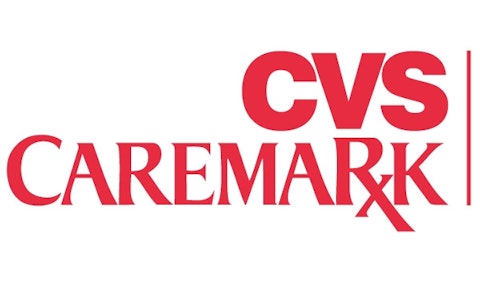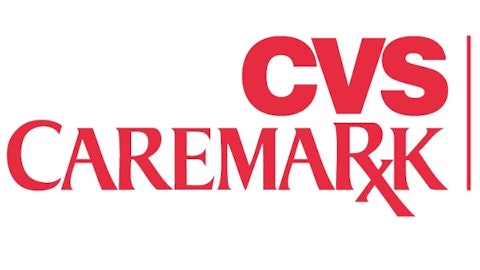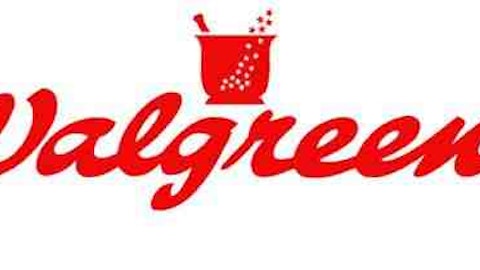CVS Caremark Corporation (NYSE:CVS)’s earnings pushed the entire pharmacy space lower on Tuesday, but was the report really that bad, and are stocks in the industry worth buying?
The patent cliff
CVS Caremark Corporation (NYSE:CVS) ticked lower by almost 3% on Tuesday, taking the stock’s year-to-date gains to 24%. For the quarter, we saw the recurring event of weaker revenue and higher margins caused by new generic introductions.
CVS Caremark Corporation (NYSE:CVS)’ revenue grew 1.7% year-over-year, but more importantly, its EPS grew nearly 20%, representing a massive rise in margins. This rise was created by a 5% boost in 30-day prescription volume for the quarter.
In my opinion, CVS Caremark Corporation (NYSE:CVS) produced a great quarter, and continues to benefit from a natural macro shift, also called the patent cliff in biotechnology. It involves more than $130 billion in brand drug sales losing their patents between the years of 2011 and 2016.

The macro impact
As I explained in a previous article, the best days are yet to come for pharmacies. Despite being the most efficient U.S. pharmacy, CVS Caremark Corporation (NYSE:CVS)’ performance has been the least impressive. In 2013, Walgreen Company (NYSE:WAG) rose 36% and Rite Aid Corporation (NYSE:RAD) has increased an impressive 135%. However, I don’t think the gains are over.
Next year should be incredible for new generic drug introductions. Most notably, Nexium, Cymbalta, Celebrex, Evista, Sandostatin, Actonel, and Symbicort will lose their patents, among many other blockbusters. With just these seven noted drugs, nearly $19 billion in revenue will lose their patents. In 2015, drugs such as Abilify, Copaxone, Gleevec, and Crestor will face generic pressure, which is another $18.5 billion in annual revenue.
Therefore, while margins for pharmacies have enjoyed massive gains over the last year, including Rite Aid Corporation (NYSE:RAD)’s first profitable year in more than six years, the industry’s margins should continue to rise in 2014 and 2015.
Which is the best?
In my opinion, any sign of stock weakness should be used as a buying opportunity for pharmacies. Because despite large stock gains, the entire space is still very cheap relative to the S&P 500.
| CVS | Walgreen | Rite Aid | S&P 500 (SPY) | |
|---|---|---|---|---|
| Forward P/E Ratio | 13.45 | 14.19 | 12.1 | 14.5 |
| Price/Sales | 0.61 | 0.67 | 0.12 | 1.54 |
| Profit Margin | 3.3% | 3% | 0.94% | N/A |
| Dividend Yield | 1.5% | 2.5% | N/A | 2.08% |
As you can see, each of these stocks are significantly cheaper than the S&P 500. In particular, CVS Caremark Corporation (NYSE:CVS) is the most efficient in the space, with a profit margin of 3.3%. However, I think both Walgreen Company (NYSE:WAG) and Rite Aid Corporation (NYSE:RAD)are better investment options.
Walgreen is a little more expensive on a price/sales basis, but has a stronger retail business. Also, Walgreen Company (NYSE:WAG) pays a higher dividend and has operating margins of 4.82%, which is more than 1% lower than CVS Caremark Corporation (NYSE:CVS). In this particular case, I prefer lower margins, because it means more room for improvement in a space that has exploding margin growth. To me, CVS and Walgreen are very similar, and are both great investments, but the dividend separates Walgreen from CVS.
To me, Rite Aid Corporation (NYSE:RAD) is the clear choice as the best investment in the space. First off, just look at its price/sales relative to CVS Caremark Corporation (NYSE:CVS) and Walgreen Company (NYSE:WAG): Rite Aid is five times cheaper than Walgreen relative to sales. When you look at Rite Aid’s profit margin, you can see why it is cheaper. However, due to new generic introductions, Rite Aid’s fundamental progress has been unprecedented.



